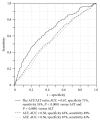Association of the Aspartate Aminotransferase to Alanine Aminotransferase Ratio with BNP Level and Cardiovascular Mortality in the General Population: The Yamagata Study 10-Year Follow-Up
- PMID: 27872510
- PMCID: PMC5107869
- DOI: 10.1155/2016/4857917
Association of the Aspartate Aminotransferase to Alanine Aminotransferase Ratio with BNP Level and Cardiovascular Mortality in the General Population: The Yamagata Study 10-Year Follow-Up
Abstract
Background. Early identification of high risk subjects for cardiovascular disease in health check-up is still unmet medical need. Cardiovascular disease is characterized by the superior increase in aspartate aminotransferase (AST) to alanine aminotransferase (ALT). However, the association of AST/ALT ratio with brain natriuretic peptide (BNP) levels and cardiovascular mortality remains unclear in the general population. Methods and Results. This longitudinal cohort study included 3,494 Japanese subjects who participated in a community-based health check-up, with a 10-year follow-up. The AST/ALT ratio increased with increasing BNP levels. And multivariate logistic analysis showed that the AST/ALT ratio was significantly associated with a high BNP (≥100 pg/mL). There were 250 all-cause deaths including 79 cardiovascular deaths. Multivariate Cox proportional hazard regression analysis revealed that a high AST/ALT ratio (>90 percentile) was an independent predictor of all-cause and cardiovascular mortality after adjustment for confounding factors. Kaplan-Meier analysis demonstrated that cardiovascular mortality was higher in subjects with a high AST/ALT ratio than in those without. Conclusions. The AST/ALT ratio was associated with an increase in BNP and was predictive of cardiovascular mortality in a general population. Measuring the AST/ALT ratio during routine health check-ups may be a simple and cost-effective marker for cardiovascular mortality.
Figures





Similar articles
-
Association between aminotransferase/alanine aminotransferase ratio and cardiovascular disease mortality in patients on peritoneal dialysis: a multi-center retrospective study.BMC Nephrol. 2020 Jun 1;21(1):209. doi: 10.1186/s12882-020-01840-7. BMC Nephrol. 2020. PMID: 32487078 Free PMC article.
-
Association between aspartate aminotransferase to alanine aminotransferase ratio and mortality in critically ill patients with congestive heart failure.Sci Rep. 2024 Nov 1;14(1):26317. doi: 10.1038/s41598-024-77141-y. Sci Rep. 2024. PMID: 39487164 Free PMC article.
-
Brain natriuretic peptide between traditional and nontraditional risk factors in hemodialysis patients: analysis of cardiovascular mortality in a two-year follow-up.Nephron Clin Pract. 2011;119(2):c162-70. doi: 10.1159/000327615. Epub 2011 Jul 8. Nephron Clin Pract. 2011. PMID: 21757955
-
AST to ALT ratio and arterial stiffness in non-fatty liver Japanese population:a secondary analysis based on a cross-sectional study.Lipids Health Dis. 2018 Dec 3;17(1):275. doi: 10.1186/s12944-018-0920-4. Lipids Health Dis. 2018. PMID: 30509277 Free PMC article. Review.
-
Elevated liver enzymes and cardiovascular mortality: a systematic review and dose-response meta-analysis of more than one million participants.Eur J Gastroenterol Hepatol. 2019 May;31(5):555-562. doi: 10.1097/MEG.0000000000001353. Eur J Gastroenterol Hepatol. 2019. PMID: 30614883
Cited by
-
Association Between Urinary Protein-to-Creatinine Ratio and Chronic Kidney Disease Progression: A Secondary Analysis of a Prospective Cohort Study.Front Med (Lausanne). 2022 Mar 31;9:854300. doi: 10.3389/fmed.2022.854300. eCollection 2022. Front Med (Lausanne). 2022. PMID: 35433766 Free PMC article.
-
Non-linear relationship between high-density lipoprotein cholesterol and incident diabetes mellitus: a secondary retrospective analysis based on a Japanese cohort study.BMC Endocr Disord. 2022 Jun 18;22(1):163. doi: 10.1186/s12902-022-01074-8. BMC Endocr Disord. 2022. PMID: 35717187 Free PMC article.
-
Relationship between De Ritis and clinical outcomes in patients with aneurysmal subarachnoid hemorrhage: Insights from the LongTEAM registry.Sci Rep. 2025 Apr 10;15(1):12314. doi: 10.1038/s41598-025-90843-1. Sci Rep. 2025. PMID: 40210942 Free PMC article.
-
Association of Liver Fibrosis Markers with Mortality Outcomes in Patients with Chronic Kidney Disease and Coronary Artery Disease: Insights from the NHANES 1999-2018 Data.Cardiorenal Med. 2025;15(1):153-163. doi: 10.1159/000543500. Epub 2025 Jan 21. Cardiorenal Med. 2025. PMID: 39837280 Free PMC article.
-
Association between Triglyceride-Glucose index and onset of type 2 diabetes in metabolic Dysfunction-Associated steatotic liver disease population.Sci Rep. 2025 May 23;15(1):18044. doi: 10.1038/s41598-025-03453-2. Sci Rep. 2025. PMID: 40410296 Free PMC article.
References
-
- Tsutamoto T., Wada A., Maeda K., et al. Attenuation of compensation of endogenous cardiac natriuretic peptide system in chronic heart failure: prognostic role of plasma brain natriuretic peptide concentration in patients with chronic symptomatic left ventricular dysfunction. Circulation. 1997;96(2):509–516. doi: 10.1161/01.cir.96.2.509. - DOI - PubMed
-
- Kara K., Mahabadi A. A., Geisel M. H., et al. B-type natriuretic peptide: distribution in the general population and the association with major cardiovascular and coronary events—the Heinz Nixdorf Recall Study. Clinical Research in Cardiology. 2014;103(2):125–132. doi: 10.1007/s00392-013-0628-4. - DOI - PubMed
-
- Kawai M., Yoshimura M., Harada M., et al. Determination of the B-type natriuretic peptide level as a criterion for abnormalities in Japanese individuals in routine clinical practice: the J-ABS Multi-Center Study (Japan Abnormal BNP Standard) Internal Medicine. 2013;52(2):171–177. doi: 10.2169/internalmedicine.52.8704. - DOI - PubMed
Publication types
MeSH terms
Substances
LinkOut - more resources
Full Text Sources
Other Literature Sources
Molecular Biology Databases

